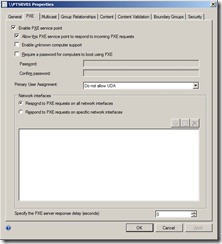I already tweeted last week that I really, really like the new Distribution Points in ConfigMgr 2012. Around that time they started writing some really good posts at the ConfigMgr OSD Blog about the new Distribution/PXE Point and Content Management. Even though these posts give really good information I still feel like I have to write down what I really, really like about it. So in this post I will sum up some of the cool new features/ properties of the new Distribution Point in ConfigMgr 2012.
- Distribution Point Role: The Distribution Point Role is now merged into one single type that can be used on workstations and server. Also there is now the ability to choose (and prioritize) two drives for the use of the Distribution Point. To me this is a logic choice as there are now no vague difference anymore in what is supported with which type of Distribution Point.
 PXE Service Point Role: The PXE Service Point is now a property of a Distribution Point. To me this is a logic choice, as there was always a Distribution Point needed when there was a PXE Service Point. Besides that it also saves a lot of confusion, because of the extra Server Share Distribution Point that got created (SMSPXEIMAGES$). Adding a Boot Image to the RemoteInstall folder of WDS is now just a property setting of a Boot Image (Deploy this boot image from the PXE Service Point).
PXE Service Point Role: The PXE Service Point is now a property of a Distribution Point. To me this is a logic choice, as there was always a Distribution Point needed when there was a PXE Service Point. Besides that it also saves a lot of confusion, because of the extra Server Share Distribution Point that got created (SMSPXEIMAGES$). Adding a Boot Image to the RemoteInstall folder of WDS is now just a property setting of a Boot Image (Deploy this boot image from the PXE Service Point). - Distribution Point Groups: The Distribution Point Groups functionality got a really nice update too. It can still be used to distribute content to multiple Distribution Points at the same time, but now it also directly distributes content (assigned to the group) to new members of the group. To me this is a really nice (and very logic) additions to this functionality, because now all the members of a group always have the same content assigned to it.
- Content: The Distribution Point now has the option to show all the content that is assigned to. It also gives the option to validate the content and to manage (redistribute or remove) the content. Also the possibility to validate the content is added. This means as much as, the hash of the content will get checked on a schedule. When the has doesn’t mach this will be reported, but not “fixed”. To me this is a great addition to finally be able to quickly see the assigned content to a Distribution Point. Also no hash mismatches anymore! Well… if the content gets checked on a regularly base and (manual) actions will be taken.
- Content Library: The Distribution Point now stores the data in the Content Library (SCCMContentLib). This library is divided in three parts, Data Library (DataLib), File Library (FileLib) and Package Library (PkgLib). The Data Library stores Metadata about files, the File Library stores actual files and the Package Library stores references to files. To me this looks like a good solution to prevent the many different times (and locations) that where used to store data on a Distribution Point.
- Boundary Groups: The Distribution Point now gets protected by adding a Boundary Group directly to it. And a Boundary Group can contain multiple Boundaries. To me this is a not necessary addition, because now there will always be the need to create a Boundary Group to be able to create a Protected Distribution Point.
More information about Content Management in ConfigMgr 2012: http://technet.microsoft.com/en-us/library/gg682003.aspx
I am using a precongiured sccm 2012. I have learned how to deploy an application but I do not know where the application is being deployed to. I have checked the users to see if the intended information is sen to them but it has not. What step am i missing?
Hi,
How did you deploy the application then? Because with deploying the application you need to select a collection to which you want to deploy the application. The user or computers in that collection will get the application.
Peter
I am setting up a proof of concept for a customer and your articals have helped me out a great deal. Thank You